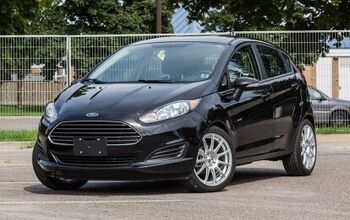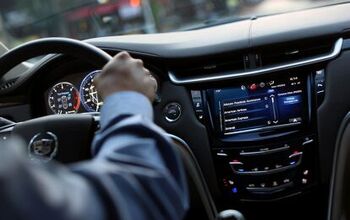All Infotainment Systems Suck

“I hate this thing,” my significant other exclaimed as she tried for the upteenth time to switch from line to USB input in our 2015 Ford Fiesta.
I was in the driver’s seat and she in the front passenger seat as she extended her hand across the cabin to depress the voice recognition button on the steering wheel. This, in her mind, is the easiest way to change the audio input source on the basic version of Ford SYNC, the much-derided infotainment system from the Blue Oval.
And she’s absolutely right. It is the easiest way to do what should be a simple function in the Fiesta. Hit the VR button, say “USB Input,” and SYNC switches from the default line input to USB. (For whatever reason, the system doesn’t remembers that we use USB input every single time.)
This method of switching audio input is also the most dangerous way to perform this function as a passenger, and I’m about to tell you why.
Ford, in an effort to achieve improved IQS scores and other goals, thoroughly revamped the touchscreen-based version of SYNC, but this basic version of SYNC — which features a monochromatic screen atop the dash and a confusing set of nested menus — still exists in our 2015 Fiesta.
If I were to bar my lovely girlfriend from reaching across the cabin to hit the VR button on the steering wheel, this is the confusing set of actions she would need to perform to make her iPhone work in the car:
- Hit the “Media” button on the dash.
- Hit the “Menu” button on the dash.
- Using the arrow buttons on the dash, scroll down to the menu item that opens another menu for audio input sources.
- Hit the “OK” button on the dash.
- Using the arrow buttons on the dash, select the input source.
- Hit the “OK” button on the dash.
That’s six very distinct actions that could be solved with a “Media Source” button that you can repeatedly mash to cycle through different audio inputs. Instead, Ford — and Microsoft, by extension — failed to provide the most basic usability for this admittedly basic system. Not only that, but the easiest way for the passenger to bypass this menu-driven servitude is to reach across the cabin — between the driver and a live airbag — just so said passenger can listen to The Weeknd on Apple Music.
Just think about that for a moment. My girlfriend could be reaching across a live airbag as I, being distracted by this, could drive into the back of a car at a stop light. Her arm then becomes an airbag-driven projectile aimed straight at my face.
But, as you can probably deduce from the title of this rare editorial from yours truly, Ford isn’t the only culprit.
This week, I’m driving the brand-new 2017 Chrysler Pacifica. For all intents and purposes, it’s a brilliant minivan. From the driver’s seat, I can have a conversation with someone in the third row without raising my voice so long as I’m not listening to Pantera or some other accident-inducing ’90s metal cranked up to 11. (Full disclosure: “11” isn’t that loud in the Pacifica. The volume goes all the way up to 30. Take that, Spinal Tap! Double full disclosure: Pantera has been playing every time I’ve been in a car accident.)
Yet, during a two-hour drive from my mother’s shoreside abode to my hometown habitation, I found my back perspiring against the Pacifica’s fine brown leather, so I went searching for the ventilated seat button — a button that simply does not exist. Instead, the Pacifica forced me through the Uconnect climate menu then into the seat climate settings to activate the little fan or whatever it is under my rump. The whole process is madness, especially when you consider the driving force behind this is some beancounter trying to remove $3 out of the total cost of producing what’s essentially a $50,000 pram.
Sometimes the decisions made by designers and engineers aren’t curbed by beancounters when they totally should be. A great (or horrible) example of this is Cadillac CUE. The MyLink variant is slow to respond and confusing to use for some people, but the worst part of Cadillac’s infotainment system lives just below the screen: the eardrum bleeding, touch-sensitive volume bar. You slide your finger along a metal bar to increase and decrease the volume as you would a slider on an old-timey radio — except it doesn’t work. You’re destined to inadvertently turn the volume up so high that your entire neighborhood will hear every single one of Ice Cube’s expletives. You can’t tell me that Cadillac’s volume bar is any cheaper to produce than a tried-and-true knob. I wish a beancounter at GM had grown some cojones and killed this from the start.
Volume selectors aren’t the only controls that need a serious rethink, and Cadillac isn’t the only luxury automaker that can’t get them right. Take the Lexus RC350 F Sport that went through our local fleet recently. The creamsicle coupe came equipped with a touchpad with haptic feedback. Every single time you used the touchpad to switch to another menu, the pad vibrates with such intensity that I thought my twitching finger was a sign of an impending seizure or stroke or some other urgent physical condition. On top of that, any finger swipe on the touchpad is represented in cursor movement at 10 times magnitude. Want to select the next menu item? Move your finger exactly 5/16ths of an inch, because moving it any farther will select a menu in a neighboring vehicle in traffic.
Why does it have to be this way? Why can’t infotainment systems simply work?
Some of them do — almost. Subaru Starlink, even in its fanciest form, is fairly straightforward to operate, but it’s not immune to gremlins as this video from our own Bozi Tatarevic will attest.
http://www.thetruthaboutcars.com/wp-content/uploads/2016/07/starlink.mp4As you can see, Starlink is slower than post-concussion Eric Lindros, and that’s before you begin to realize the entire system has all the graphical polish of a TI-89.
I could go on and on: you have to adjust the heads-up display in Mazda vehicles through the infotainment system, rear-seat HVAC controls are buried in nested menus in Uconnect similarly to the heated/cooled seat controls, and Volkswagen is introducing normal USB inputs in its vehicles in 2016, some 20 years after USB was invented.
Automakers, it’s time to get your collective shit together. You have a duty to provide safe, easy-to-use products that don’t (effectively) force drivers and passengers to make stupid decisions. You used to build vehicles that repelled the damn Nazis, fer Christ’s sake. (Or, in the case of German and Japanese automakers, you made incredible machines that repelled our own military might.)
Why can’t you figure out the easiest way to play a song on a stereo? It’s not that difficult, folks. Fix it, and fix it now.
[Image: Ford; Video: Bozi Tatarevic]
Mark Stevenson is the managing editor of The Truth About Cars. He is easily swayed into buying vehicles from brands that no longer exist. You can find him on Twitter and Facebook.

More by Mark Stevenson
Latest Car Reviews
Read moreLatest Product Reviews
Read moreRecent Comments
- Redapple2 I ve slept on it. I would take one on a 3 yr lease for $199/mo- ($1000 down total). Evil gm Vampire gave me this deal in 2012.
- 3SpeedAutomatic Would prefer a non-turbo with a stick shift. That would be more fun to drive!!🚗🚗🚗Also, I could teach my nieces and nephews to drive a standard. You'd be surprised how many folks can't handle a stick shift today. Yet, in Europe, most rental cars come with a stick unless you specify otherwise.
- Jeffrey Henry Ford said about innovation, “ If I had asked my customers what they wanted, then they would have said a faster horse." Change is inevitable!!!https://www.wri.org/insights/countries-adopting-electric-vehicles-fastest#:~:text=Currently%2C%2016%20countries%2C%20including%20Canada,create%20and%20enforce%20such%20policies.
- ToolGuy If these guys opened a hotel outside Cincinnati I would go there to sleep, and to dream.
- ToolGuy Michelin's price increases mean that my relationship with them as a customer is not sustainable. 🙁


































Comments
Join the conversation
I disagree; I've yet to find a vehicle's built-in infotainment to be difficult to use. The myLink system in my truck seems to work just fine to me. There's physical buttons and knobs for all audio functions. Not that it matters; I always use the steering wheel controls. The voice command works; but I just long-press teh button to pass it through to my Nexus which handles it MUCH better. I can scroll through radio sources (AM, FM, XM) by spamming the radio button and media sources (CD, BT audio, aux, USB, etc) as well. Interestingly enough the media button will only cycle active sources. If there is no CD, the CD player isn't part of the cycle. Sometimes its pokey, but its typically responsive enough that it doesn't irritate me. There is a panacea for this: Android Auto and Apple CarPlay. Seeing as how most people use their smartphone to carry their media; this will work just fine.
I mostly agree but I do think BMW has nailed it with idrive (atleast the last few years). It's perhaps not as instantly intuitive as, say, uconnect but once you learn its easy, fast and safe. Some highlights: -physical buttons and knibs for stuff you'd expect like cooled seats and volume knob. -nuance sourced vr actually works well but you don't need to rely on it. -shortcut buttons around controller can be used easily by feel -very fast with no delays -blyetooth works well. It pairs quickly and no one can tell I'm calling from a car -includes Google search and traffic for the first few years (Audi and others make you pay a subscription fee. The only downside is that when I drive other cars I get frustrated by some of the stupidity mentioned in this article. I also prefer it to CarPlay (which is a pretty idiotic interface)